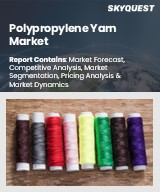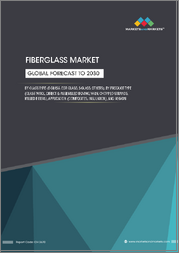
|
시장보고서
상품코드
1571520
세계의 텍스타일 원사 시장 평가 : 원사 유형별, 재료 유형별, 용도별, 지역별, 기회, 예측(2017-2031년)Textile Yarn Market Assessment, By Yarn Type [Staple Yarn, Filament Yarn], By Material Type [Natural, Synthetic, Blended], By Application [Residential, Commercial, Industrial], By Region, Opportunities and Forecast, 2017-2031F |
||||||
세계의 텍스타일 원사 시장 규모는 2023년 140억 9,000만 달러에서 2031년에 206억 9,000만 달러에 달할 것으로 예측되며, 예측 기간인 2024-2031년에 CAGR로 4.92%의 성장이 전망됩니다. 소비자 습관의 변화와 기술 발전으로 인해 시장이 크게 확대될 것으로 예상됩니다. 오가닉 코튼, 재생 폴리에스테르와 같은 지속가능하고 친환경적인 원료에 대한 수요가 증가하고 있으며, 이는 책임감 있는 소비로 점차 전환하고 있음을 보여줍니다. 또한 이러한 추세는 폐기물을 최소화하고 재료를 재사용하는 섬유 부문의 순환 경제 관행 증가로 인해 더욱 가속화되고 있습니다.
자동화와 새로운 방적 기술에 대한 투자를 포함한 원사 생산 시스템의 개발은 생산성과 효율성을 향상시켜 제조업체가 증가하는 세계 수요를 충족시킬 수 있게 했습니다. 의류, 가구, 상업용 섬유와 같은 중요한 부문의 발전이 시장 성장을 가속하고 있습니다. 또한 자동차, 의료, 건설 및 기타 부문에서 사용되는 기술 섬유에 대한 수요가 증가함에 따라 텍스타일 원사에 대한 선호도가 높아지고 있습니다.
그러나 기본 재료의 가격 변동, 생태학적 문제, 인공 섬유에 대한 규제 등의 문제가 장애물이 될 수 있습니다. 그러나 친환경 소재와 공정의 발전으로 인해 세계 텍스타일 원사 시장은 패션 및 산업 용도의 소비 증가로 인해 예측 기간 중 계속 상승세를 보일 것으로 예상됩니다.
2024년 6월, Gimatex Industries Pvt. Ltd.는 오염 물질이 없는 우수한 품질의 최고 가치 면사(CVC Yarn)와 Siro Compact Yarn을 출시했습니다. CVC Yarn은 폴리 에스터 및 기타 인공 섬유를 첨가하여 더 강하고 광택이 나는 면의 촉감을 가지고 있으며, CVC Yarn은 더 강하고 광택이 나는 원단을 생산하기 위해 컴팩트한 방적 기술을 채택하여 결함을 줄이고 전체 원사의 품질을 향상시킵니다.
세계의 텍스타일 원사 시장에 대해 조사분석했으며, 시장 규모와 예측, 시장 역학, 주요 기업의 상황 등을 제공하고 있습니다.
목차
제1장 프로젝트 범위와 정의
제2장 조사 방법
제3장 개요
제4장 고객의 소리
- 인구통계(소득 - 저소득, 중소득, 고소득, 지역, 국적 등)
- 시장의 인지도와 제품 정보
- 브랜드 인지도와 로열티
- 구입 결정에서 고려되는 요소
- 품질
- 가격
- 지속가능성
- 공급업체 평판
- 커스터마이즈 옵션
- 가용성과 리드타임
- 기술 혁신
- 시장 동향
- 규제 준수
- 고객 서비스
- 구입 채널
- 구입 빈도
- 기존 또는 예정 사용자
제5장 세계의 텍스타일 원사 시장 전망(2017-2031년)
- 시장 규모 분석과 예측
- 금액
- 수량
- 시장 점유율 분석과 예측
- 원사 유형별
- 재료 유형별
- 용도별
- 지역별
- 시장 점유율 분석 : 기업별(금액)(상위 5사와 기타 - 2023년)
- 시장 맵 분석(2023년)
- 원사 유형별
- 재료 유형별
- 용도별
- 지역별
제6장 북미의 텍스타일 원사 시장 전망(2017-2031년)
- 시장 규모 분석과 예측
- 금액
- 수량
- 시장 점유율 분석과 예측
- 원사 유형별
- 재료 유형별
- 용도별
- 점유율 : 국가별
- 각국의 시장의 평가
- 미국의 텍스타일 원사 시장 전망(2017-2031년)
- 캐나다
- 멕시코
제7장 유럽의 텍스타일 원사 시장 전망(2017-2031년)
- 독일
- 프랑스
- 이탈리아
- 영국
- 러시아
- 네덜란드
- 스페인
- 터키
- 폴란드
제8장 아시아태평양의 텍스타일 원사 시장 전망(2017-2031년)
- 인도
- 중국
- 일본
- 호주
- 베트남
- 한국
- 인도네시아
- 필리핀
제9장 남미의 텍스타일 원사 시장 전망(2017-2031년)
- 브라질
- 아르헨티나
제10장 중동 및 아프리카의 텍스타일 원사 시장 전망(2017-2031년)
- 사우디아라비아
- 아랍에미리트
- 남아프리카공화국
제11장 수급 분석
제12장 수입과 수출 분석
제13장 밸류체인 분석
제14장 Porter's Five Forces 분석
제15장 PESTLE 분석
제16장 거시경제 지표
제17장 가격 분석
제18장 이익률 분석
제19장 시장 역학
- 시장 성장 촉진요인
- 시장이 해결해야 할 과제
제20장 시장의 동향과 발전
제21장 사례 연구
제22장 경쟁 구도
- 시장 리더 상위 5사의 경쟁 매트릭스
- 기업 에코시스템 분석(스타트업 vs. 중소기업 vs. 대기업)
- 상위 5사의 SWOT 분석
- 주요 기업 상위 10사의 상황
- Celanese Corporation
- Huvis Corp.
- Weiqiao Textile Co., Ltd.
- Glen Raven, Inc.
- Masood Textile Mills Ltd
- Hengli Group Co., Ltd.
- Grasim Industries Limited
- SCHOELLER TEXTIL AG
- Parkdale, Incorporated
- Asahi Kasei Corporation
제23장 전략적 추천
제24장 Market Xcel - Markets and Data 소개, 면책사항
KSA 24.10.24Global textile yarn market is projected to witness a CAGR of 4.92% during the forecast period 2024-2031, growing from USD 14.09 billion in 2023 to USD 20.69 billion in 2031. The market is expected to witness substantial expansion owing to changing consumer habits and better technologies. There has been a growing demand for sustainable and eco-friendly raw materials, such as organic cotton and recycled polyester, indicating a gradual move towards responsible consumption. Additionally, this trend is supported by the increasing practice of circular economy in the textile sector, which aims at waste minimization and materials reuse.
The developments in the yarn production systems, which include investments in automation and new spinning techniques, have improved productivity and efficiency, enabling the manufacturers to satisfy the increasing global need. The development of some crucial segments, such as clothing, home furnishings, and business textiles, has stimulated the growth of the market. Furthermore, the inclination towards textile yarns has risen owing to the growing demand for technical textiles, which are utilized in sectors such as automotive, medical, and construction.
Nonetheless, issues such as the volatility of prices for basic materials, ecological issues, and legislative restrictions on artificial fibers may present obstacles. However, with the advancements in eco-friendly materials and processes, the global textile yarn market is anticipated to continue demonstrating an upward trend within the forecast period due to increased consumption for fashion and industrial applications.
In June 2024, Gimatex Industries Pvt. Ltd. introduced excellent quality Chief Value Cotton Yarns (CVC Yarns) and Siro Compact Yarns with an option free of contaminants. The production process of Siro Compact Yarns uses compact spinning technology, which reduces flaws and improves the yarn's overall quality, producing fabrics that are stronger and smoother. CVC yarns have a touch of cotton that is stronger and has a higher gloss due to the addition of polyester or other man-made fibers.
Rising Demand for Sustainable Textiles Catalyzes Market Expansion
The increasing need for eco-friendly fabrics is dramatically transforming the global textile yarn market. There is a growing concern on the part of consumers and industries towards environmental issues and climate change, resource depletion, and the negative effects of traditional textile manufacturing. Consequently, green polymers such as organic cotton, bamboo, hemp, and recycled polyester are becoming more common. These green alternatives make use of less water, energy, and harmful chemicals in their production processes, reducing the overall impact on the environment.
Furthermore, companies and brands follow the circular economy model by encouraging the use of products that are made out of either renewable or recycled materials. This is especially true for the fashion sector, where conscious consumerism is highly prevalent, and consumers are advocating for the use of sustainable practices and activities in the supply chains, leading to the emergence of sustainable fashion movements.
As sustainability is becoming an essential component in every consumer's buying choice, the textile yarn market is experiencing a rising demand for fibers that are environmentally friendly and ethical, propelling the sustainable textiles trend as one of the most important factors contributing to the growth of the market in the forecast period.
In June 2023, Rubi Laboratories, Inc., based in the United States, and GANNI A/S, based in Denmark, introduced a yarn that is manufactured entirely of carbon emissions through an enzymatic process. These firms believe that yarn is neutral to land and water. The yarn samples come from a process called carbon sequestration, which is based on the idea that trees breathe CO2 and are inspired by photosynthesis.
Customization and Innovation to Fuel Market Growth
The textile yarn market is majorly influenced by innovation and customization, particularly due to the need for specialized and high-performance materials in different sectors. The manufacturers' attention is increasingly turning towards producing yarns with special characteristics to satisfy particular clientele's requirements. Companies are working on developing yarns for moisture management in sports apparel, flame-resistant fabrics for workwear, and antimicrobial yarns used in surgical sutures and other medical textiles. Such specialized yarns provide improved functional attributes and are therefore sought after in industries such as sports, health, and construction.
Other than the performance, customization with color, texture, and fiber blends is growing in significance as brands look to stand out in a competitive environment. For instance, in June 2023, Ferney Spinning Mills, in partnership with Floreal Knitwear Ltd., introduced its latest yarn collection, Otenya, made up of Spiber's Brewed Protein fibers. The company became the first in the world to introduce such a collection of yarns. The Brewed Protein fibers are plant-based, circular protein materials produced in a lab using a patented fermentation process that uses sugars supplied from plants as the main raw material for microbes.
Moreover, the process of yarn production is becoming more efficient and accurate due to the increase in automation and application of advanced spinning technologies, which, in turn, helps produce tailored products more easily.
Filament Yarn Holds a Significant Market Share
Filament yarns occupy a large market share in the global textile yarn market owing to their distinct features and varied uses. Filament yarn, such as polyester, nylon, and silk, is made of long and continuous threads as opposed to staple yarn. Due to these qualities, filament yarn is ideal for many industries, such as clothing, household fabric, and textiles, and it is engineered particularly for functional purposes.
There is a high demand for filament yarn in the apparel category, more precisely in the activewear sector, where it is appreciated for its strength and moisture-wicking ability. Furthermore, in the industrial field, filament yarn serves to produce products such as seat belts, geotextiles, and tire cords, which require a considerable degree of strength and elasticity.
Another contributing factor to its supremacy is the increase in the activities of the garment and home furnishing industries and the advancements in filament-spinning technologies. Aligning with the ongoing trend, in August 2024, UNIFI, Inc. introduced its latest white-dyeable filament yarn, making its circular REPREVE the largest portfolio of regenerated performance polyester across the globe. The yarn is based on 100% recycled polyester raw material, with at least 50% of the volume produced from textile waste due to the company's patented Textile Takeback process. The product is intended for use in the manufacturing of home textiles, such as, quilts and pillows, and is dyeable using conventional methods.
Europe to Dominate Market Share
The predominant position of Europe in the global textile yarn market can be attributed to its strong manufacturing base, sophisticated technology, and high consumption of quality textiles. Several fashion houses and textile producers, especially those situated in Italy, France, and Germany, are known to be the epicenter of luxury fabrics and creative yarns, and are well-represented in the region.
European economies have a good infrastructure, and trained manpower and are mainly concentrated on the production of high-technical and specialized yarn products. Prominent sectors such as the textile and apparel industry, automotive, and household textiles have increased the consumption of natural and man-made yarns. In addition, the Europeans' orientation on innovation and design has led to the introduction of bespoke yarn solutions for varying industries.
The stringent rules and high demands of consumers for quality and performance in the region have pushed yarn production to new heights. Consequently, Europe is at the forefront of the industry, with notably growing demand for high-end luxurious textiles and technical textile fabrics.
In June 2024, Italy-based Fulgar SpA launched its latest polyamide yarn, Q-Geo, which is a bio-based textile yarn. 46% of the fiber incorporating bio-based polyamide is derived from corn that is overripe or no longer fit for consumption. It is sourced from agricultural practices on land, which is not productive for food crops.
Future Market Scenario (2024 - 2031F)
The future market will experience a growing demand for specialty yarns with advanced functions, such as moisture management, flame-retardancy, and microbial resistance, especially in industries such as sports and healthcare.
Even though the use of natural fibers remains intact, the yarn produced from synthetic fibers, such as polyester and nylon, is seen to continue being in high demand owing to its strength, cost-effectiveness, and versatile use across industries.
It is anticipated that there will be a heightened emphasis on premium and luxury yarns in the market due to the rising demand from consumers who appreciate high fashion and decor textiles.
Key Players Landscape and Outlook
The global textile yarn market is characterized by a diverse landscape of key players, ranging from large-scale manufacturers to specialized producers focusing on niche segments. These players are driving market growth through innovation, customization, and expansion into emerging markets. Many have established a strong presence in regions such as Asia-Pacific, Europe, and North America, leveraging advanced production technologies and a vast distribution network to meet global demand.
One of the major trends among key players is the increasing focus on high-performance yarns designed for specific applications, such as activewear, industrial textiles, and technical fabrics, which is expected to grow. Companies are investing in research and development to enhance the durability, strength, and functionality of their yarns, catering to evolving consumer preferences. For instance, in January 2024, Celanese Corporation collaborated with Under Armour, Inc. to introduce its latest material for performance stretch fabrics, NEOLAST, an alternative to elastane. NEOLAST fibers are manufactured using a patented solvent-free melt-extrusion technique without any dangerous chemicals that are usually used to make elastane-based stretch fabrics.
The outlook for key players in the textile yarn market remains positive, with opportunities for growth in emerging markets and premium segments. Innovation, sustainability, and the ability to adapt to changing market demands will be critical for maintaining competitive advantages in the rapidly evolving textile industry.
Table of Contents
1. Project Scope and Definitions
2. Research Methodology
3. Executive Summary
4. Voice of Customer
- 4.1. Demographics (Income - Low, Mid and High; Geography; Nationality; etc.)
- 4.2. Market Awareness and Product Information
- 4.3. Brand Awareness and Loyalty
- 4.4. Factors Considered in Purchase Decision
- 4.4.1. Quality
- 4.4.2. Price
- 4.4.3. Sustainability
- 4.4.4. Supplier Reputation
- 4.4.5. Customization Options
- 4.4.6. Availability and Lead Time
- 4.4.7. Technological Innovation
- 4.4.8. Market Trends
- 4.4.9. Regulatory Compliance
- 4.4.10. Customer Service
- 4.5. Purchase Channel
- 4.6. Frequency of Purchase
- 4.7. Existing or Intended User
5. Global Textile Yarn Market Outlook, 2017-2031F
- 5.1. Market Size Analysis & Forecast
- 5.1.1. By Value
- 5.1.2. By Volume
- 5.2. Market Share Analysis & Forecast
- 5.2.1. By Yarn Type
- 5.2.1.1. Staple Yarn
- 5.2.1.2. Filament Yarn
- 5.2.2. By Material Type
- 5.2.2.1. Natural
- 5.2.2.1.1. Plant
- 5.2.2.1.2. Animal
- 5.2.2.2. Synthetic
- 5.2.2.2.1. Polyester
- 5.2.2.2.2. Nylon
- 5.2.2.2.3. Acrylic
- 5.2.2.2.4. Others
- 5.2.2.3. Blended
- 5.2.2.1. Natural
- 5.2.3. By Application
- 5.2.3.1. Residential
- 5.2.3.2. Commercial
- 5.2.3.3. Industrial
- 5.2.4. By Region
- 5.2.4.1. North America
- 5.2.4.2. Europe
- 5.2.4.3. Asia-Pacific
- 5.2.4.4. South America
- 5.2.4.5. Middle East and Africa
- 5.2.5. By Company Market Share Analysis (Top 5 Companies and Others - By Value, 2023)
- 5.2.1. By Yarn Type
- 5.3. Market Map Analysis, 2023
- 5.3.1. By Yarn Type
- 5.3.2. By Material Type
- 5.3.3. By Application
- 5.3.4. By Region
6. North America Textile Yarn Market Outlook, 2017-2031F*
- 6.1. Market Size Analysis & Forecast
- 6.1.1. By Value
- 6.1.2. By Volume
- 6.2. Market Share Analysis & Forecast
- 6.2.1. By Yarn Type
- 6.2.1.1. Staple Yarn
- 6.2.1.2. Filament Yarn
- 6.2.2. By Material Type
- 6.2.2.1. Natural
- 6.2.2.1.1. Plant
- 6.2.2.1.2. Animal
- 6.2.2.2. Synthetic
- 6.2.2.2.1. Polyester
- 6.2.2.2.2. Nylon
- 6.2.2.2.3. Acrylic
- 6.2.2.2.4. Others
- 6.2.2.3. Blended
- 6.2.2.1. Natural
- 6.2.3. By Application
- 6.2.3.1. Residential
- 6.2.3.2. Commercial
- 6.2.3.3. Industrial
- 6.2.4. By Country Share
- 6.2.4.1. United States
- 6.2.4.2. Canada
- 6.2.4.3. Mexico
- 6.2.1. By Yarn Type
- 6.3. Country Market Assessment
- 6.3.1. United States Textile Yarn Market Outlook, 2017-2031F*
- 6.3.1.1. Market Size Analysis & Forecast
- 6.3.1.1.1. By Value
- 6.3.1.1.2. By Volume
- 6.3.1.2. Market Share Analysis & Forecast
- 6.3.1.2.1. By Yarn Type
- 6.3.1.2.1.1. Staple Yarn
- 6.3.1.2.1.2. Filament Yarn
- 6.3.1.2.2. By Material Type
- 6.3.1.2.2.1. Natural
- 6.3.1.2.2.1.1. Plant
- 6.3.1.2.2.1.2. Animal
- 6.3.1.2.2.2. Synthetic
- 6.3.1.2.2.2.1. Polyester
- 6.3.1.2.2.2.2. Nylon
- 6.3.1.2.2.2.3. Acrylic
- 6.3.1.2.2.2.4. Others
- 6.3.1.2.2.3. Blended
- 6.3.1.2.3. By Application
- 6.3.1.2.3.1. Residential
- 6.3.1.2.3.2. Commercial
- 6.3.1.2.3.3. Industrial
- 6.3.1.2.1. By Yarn Type
- 6.3.1.1. Market Size Analysis & Forecast
- 6.3.2. Canada
- 6.3.3. Mexico
- 6.3.1. United States Textile Yarn Market Outlook, 2017-2031F*
All segments will be provided for all regions and countries covered
7. Europe Textile Yarn Market Outlook, 2017-2031F
- 7.1. Germany
- 7.2. France
- 7.3. Italy
- 7.4. United Kingdom
- 7.5. Russia
- 7.6. Netherlands
- 7.7. Spain
- 7.8. Turkey
- 7.9. Poland
8. Asia-Pacific Textile Yarn Market Outlook, 2017-2031F
- 8.1. India
- 8.2. China
- 8.3. Japan
- 8.4. Australia
- 8.5. Vietnam
- 8.6. South Korea
- 8.7. Indonesia
- 8.8. Philippines
9. South America Textile Yarn Market Outlook, 2017-2031F
- 9.1. Brazil
- 9.2. Argentina
10. Middle East and Africa Textile Yarn Market Outlook, 2017-2031F
- 10.1. Saudi Arabia
- 10.2. UAE
- 10.3. South Africa
11. Demand Supply Analysis
12. Import and Export Analysis
13. Value Chain Analysis
14. Porter's Five Forces Analysis
15. PESTLE Analysis
16. Macro-economic Indicators
17. Pricing Analysis
18. Profit Margin Analysis
19. Market Dynamics
- 19.1. Market Drivers
- 19.2. Market Challenges
20. Market Trends and Developments
21. Case Studies
22. Competitive Landscape
- 22.1. Competition Matrix of Top 5 Market Leaders
- 22.2. Company Ecosystem Analysis (Startup v/s SME v/s Large-scale)
- 22.3. SWOT Analysis for Top 5 Players
- 22.4. Key Players Landscape for Top 10 Market Players
- 22.4.1. Celanese Corporation
- 22.4.1.1. Company Details
- 22.4.1.2. Key Management Personnel
- 22.4.1.3. Products and Services
- 22.4.1.4. Financials (As Reported)
- 22.4.1.5. Key Market Focus and Geographical Presence
- 22.4.1.6. Recent Developments/Collaborations/Partnerships/Mergers and Acquisition
- 22.4.2. Huvis Corp.
- 22.4.3. Weiqiao Textile Co., Ltd.
- 22.4.4. Glen Raven, Inc.
- 22.4.5. Masood Textile Mills Ltd
- 22.4.6. Hengli Group Co., Ltd.
- 22.4.7. Grasim Industries Limited
- 22.4.8. SCHOELLER TEXTIL AG
- 22.4.9. Parkdale, Incorporated
- 22.4.10. Asahi Kasei Corporation
- 22.4.1. Celanese Corporation
Companies mentioned above DO NOT hold any order as per market share and can be changed as per information available during research work.



















